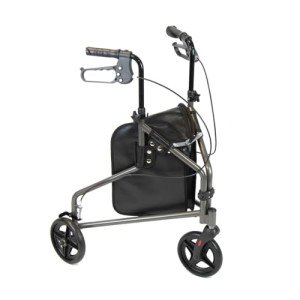Some Wisdom On Rollator Walker From An Older Five-Year-Old
페이지 정보

본문

Rollator Walker Safety: A Comprehensive Guide
As individuals age or face mobility obstacles due to disease or injury, maintaining self-reliance typically becomes a concern. Rollator walkers, supplying both assistance and mobility, have actually ended up being important tools for numerous. However, while they use many benefits, ensuring safety while utilizing a rollator walker is critical. This article supplies detailed insights into rollator walker safety, including best practices, common risks, and necessary suggestions for users and caretakers.
Understanding Rollators
A rollator walker is a mobility gadget with wheels that permits people to stroll with the assistance of a frame. Unlike standard walkers, rollators usually feature:

- Three or 4 wheels for easier maneuverability
- Hand brakes for stopping and controlling speed
- A seat for resting when required
- Storage compartments for bring individual items
These functions make rollators suitable for both indoor and outdoor use, improving the lifestyle for users by supplying a sense of self-reliance.
Benefits of Using Rollator Walkers
- Increased Mobility: Rollators can help users in moving safely and comfortably.
- Support and Stability: With a sturdy frame and brakes, they provide vital assistance when standing or walking.
- Comfort: Many rollators included padded seats, enabling users to rest as required.
- Convenience: Integrated storage solutions can carry necessary products, releasing hands for better balance.
Common Hazards Associated with Rollator Walkers
While rollators can improve mobility and safety, they can likewise pose dangers. Users must understand potential threats to reduce accidents:
- Uneven Surfaces: Rollators might tip over if used on irregular or sloped surface.
- Braking Issues: Failing to engage the brakes effectively can result in falls.
- Excess Weight: Overloading the storage compartments can impact stability.
- Inappropriate Use: Not making use of the rollator as meant can result in accidents.
- Poor Maintenance: Neglecting regular look at wheels and brakes might lead to failure during use.
Rollator Walker Safety Tips
To boost safety while utilizing rollator walkers, think about the following suggestions:
1. Appropriate Fit and Adjustment
- Height Adjustment: Ensure that the handle height is set to the user's wrist level when standing upright. An appropriate fit encourages much better posture and control.
- Seat Height: If the rollator has a seat, guarantee it's comfortable and accessible for resting.
2. Routine Maintenance
- Check Brakes: Make sure hand brakes are operating effectively. Change or replace them if necessary.
- Check Wheels: Regularly inspect wheels for wear and tear, and ensure they spin freely.
- Take a look at Frame: Check for loose screws or fractures in the frame to guarantee it stays sturdy.
| Upkeep Task | Frequency |
|---|---|
| Brake check | Weekly |
| Wheel examination | Month-to-month |
| Frame assessment | Regular monthly |
3. Environment Awareness
- Clear Pathways: Keep living spaces complimentary from clutter and barriers that might present a tripping danger.
- Lighting: Ensure that areas are well-lit to avoid bad moves, specifically throughout night hours.
- Prevent Slippery Floors: Be careful on damp or waxed floors, as they can lead to falls.
4. Safe Walking Techniques
- Engage Brakes When Stopping: Always engage brakes before sitting or while resting.
- Use Proper Walking Technique: Move slowly and maintain a stable rate, taking steps that match the rollator's width.
- Balance While Turning: Turn carefully, using the rollator for assistance as required.
5. Seek Assistance
- Include Caregivers: Encourage member of the family or caretakers to help in navigating tough surfaces or circumstances.
- Benefit From Community Resources: Many neighborhoods provide mobility training for those using walk-assisting gadgets.
FAQs about Rollator Walker Safety
Q1: How do I pick the ideal rollator walker?
When selecting a rollator, consider the user's weight, height, and meant use. It's also vital to look for features such as hand brake effectiveness and wheel size, which can impact maneuverability.
Q2: Can I use a rollator walker on irregular surfaces?
While rollators can deal with a variety of terrains, it is best to prevent steep inclines, gravel, or cobblestones, as these can be hazardous. Stick to flat, smooth surface areas whenever possible.
Q3: How can I avoid falls while utilizing a rollator?
Engaging the brakes when sitting, keeping pathways clear, adjusting your rollator for the right height, and being conscious of your surroundings can greatly minimize the threat of falls.
Q4: Are all rollator walkers the exact same?
No, rollators can be found in various types and sizes, designed for various needs. Some might have additional accessories like baskets, while others are lightweight or function a greater weight capacity.
Q5: Is it safe to carry bags on a rollator?
Always be mindful of the weight limitation and distribution of the load. Use the rollator's designated storage solutions and prevent straining it.
Rollator walkers are invaluable devices that boost mobility and promote independence for users dealing with mobility challenges. Nevertheless, ensuring safety while utilizing these devices is vital. By understanding prospective risks, adhering to safe practices, and preserving the walker frequently, users can delight in the benefits of their rollator with minimized danger. Ultimately, the objective is to facilitate self-confidence and stability, making it possible for people to navigate their world with security and ease. As care suppliers, member of the family, and neighborhoods prioritize safety, they empower users towards a better, more independent quality of life.
- 이전글Починка кнопки холодного обдува Dyson Supersonic самостоятельно 25.07.09
- 다음글구월동치과 구월동치과, 임플란트 적기 놓치면 후회하는 이유! 25.07.09
댓글목록
등록된 댓글이 없습니다.

